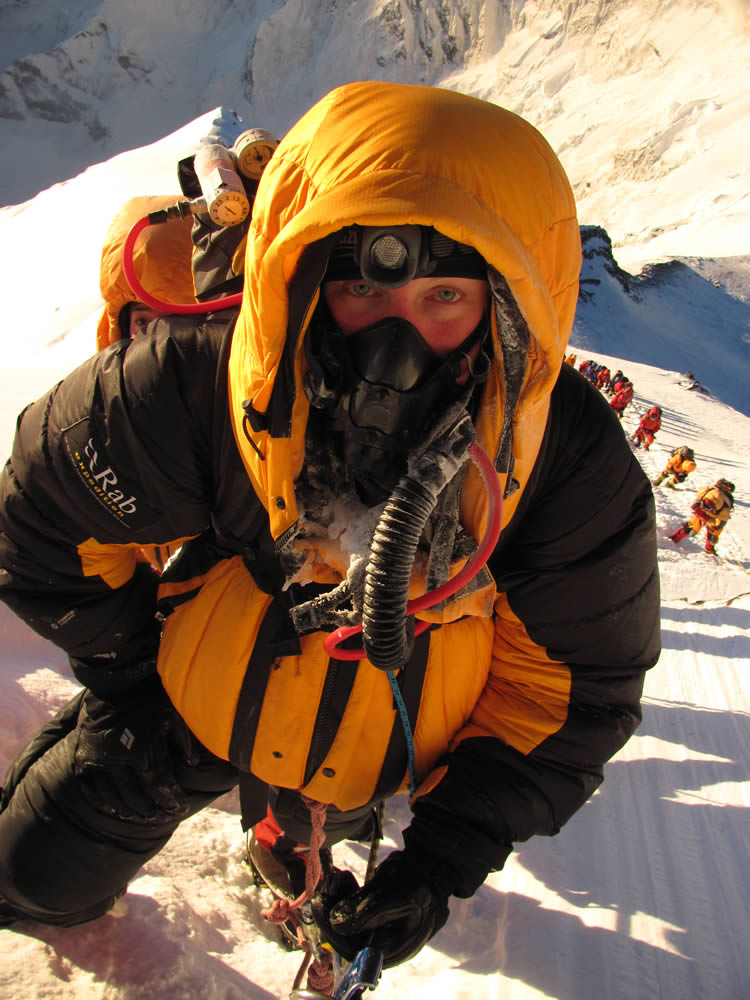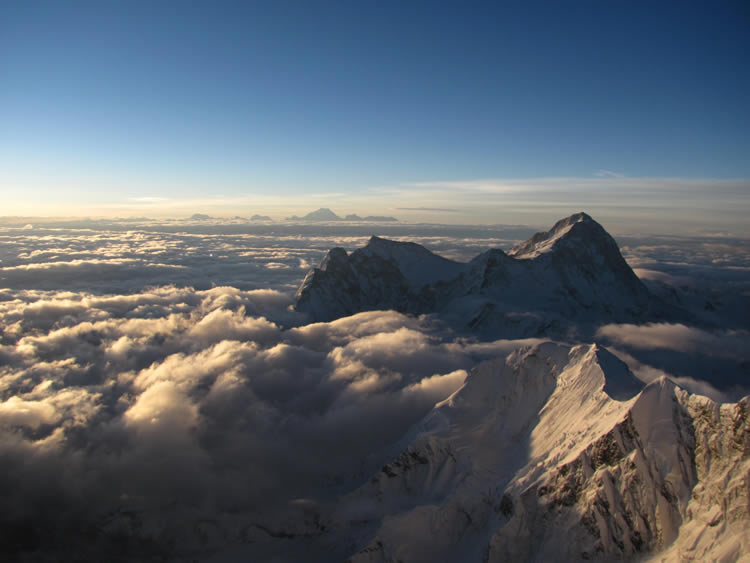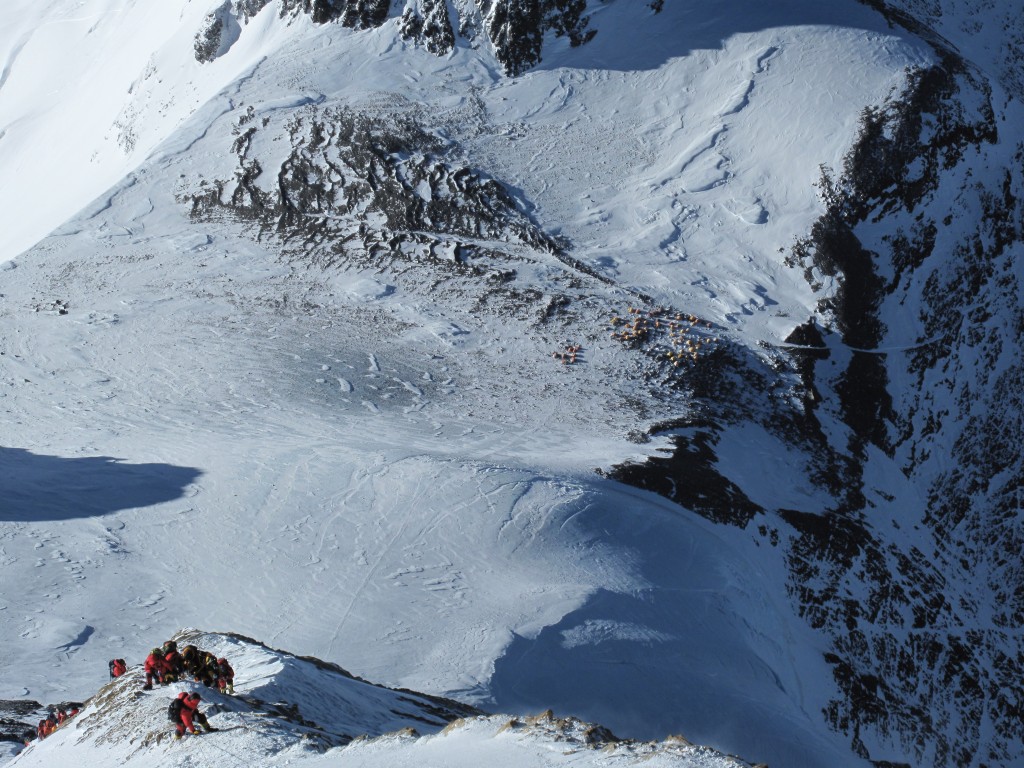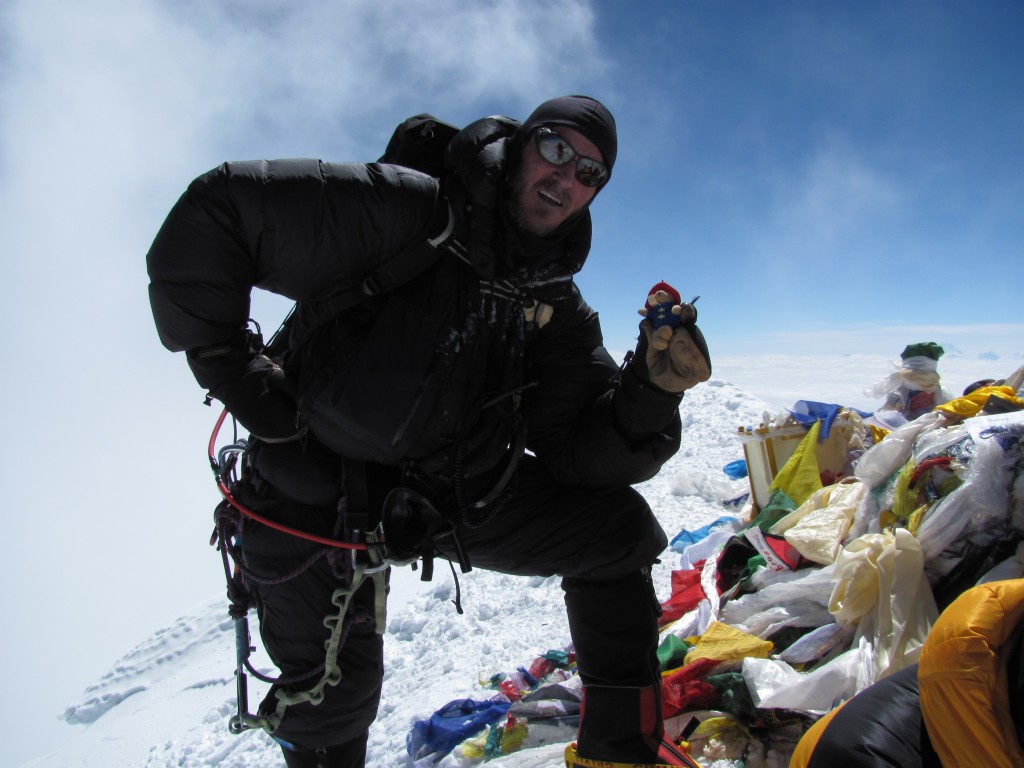Everest
South Col Route

This is about as fully inclusive a trip you can get. My belief is that when you are spending this amount of money there should not be any hidden extras or anything that is an additional buy in.
What is included?
- Peak fees
- Liaison Officer
- Base Camp manager
- Sirdar
- Cook crew
- Climbing Sherpa
- Climbing Sherpa equipment allowance
- Insurance for Base Camp crew
- Insurance for the porters
- Insurance for the Sherpa crew
- Necessary non refundable helicopter bond for in country crew in case of emergency evacuation
- SPCC Icefall fixing fee
- Fee for using ropes on Lhotse Face and above
- HRA contribution for medical treatment at Base Camp if required
- Oxygen as required (See Note 1).
- SummitOxygen Oxygen mask
- Regulator
- Administration fee for our expedition agent in Nepal – we use one of the premiere expedition agencies in KTM. They have a proven track record of providing an excellent service, are able to provide full support throughout the expedition and have a tried and tested emergency call out procedure should the need arise
- My fee for administration and planning prior to the expedition and technical support, guiding, instruction, planning and logistics during the expedition
- 3 nights’ hotel accommodation in KTM (2 at the start and one at the end)
- All group meals in KTM at the beginning of the trip
- KTM / Lukla / KTM return flight arrangements
- Teahouses accommodation for the 3 week trek in (Note 2)
- All group feeding arrangements to Base Camp
- A generous 50Kg baggage allowance KTM – Base Camp – KTM
- Living arrangements during our stay at Base Camp on a full board basis (this includes 3 course meals, services of cook crew, full porter support to / from Base Camp, camping equipment, kitchen tent, dining tent, toilet tent, kitchen utensils etc)
- Lots and lots of snacks and goodies that you won’t find at other camps (Note 3)
- Personal spacious Base Camp tent with foam mattress
- Shower facilities
- Daily weather information
- All food and fuel above Base Camp
- Mountain tents
- Cookers, stove boards etc above Base Camp
- Group Mess tent at Camp 2 (with gas heater and electric lighting! There’s no need to be uncomfortable just because you’re at 6,400M)
- Kitchen tent and cook at Camp 2
- Walkie Talkie Radios for use on the mountain
- Comprehensive 1st aid kit including antibiotics and medicines for use at altitude
- Emergency oxygen available for use on the mountain.
- Airport transfers in KTM
Have a look at my blog entry about comparing like for like for a bit more explanation about the benefits and how this trip differs from others. Remember that when comparing apples with apples you should at least start out with apples.
What’s not included in the costs
- International flight (approx £650 – £950. Please arrange a ticket that is flexible so that you can change the dates if you summit early and want to head back to the UK ahead of schedule. Alternatively get a single outbound ticket which means you have a lot of flexibility to fly home on a flight of your choice.
- Nepalese 90 day multiple entry Visa (approx £75 / US$100)
- Inoculation / vaccination costs
- Travel and medical insurance – MUST be valid for Everest. Try Global Rescue or Ripcord
- Hire of any equipment for personal use
- Tips for the staff (approx US$350 in to the kitty)
- Climbing Sherpa Summit day bonus (US$1,500. Payable the moment you step foot above the South Col – even if you don’t summit)
- Excess baggage charges
- Drinks with meals in Kathmandu
- Any drinks and/or food during the trek other than that which is provided by the crew (e.g. soft drinks, snacks, alcohol, etc etc)
- Any teahouse and feeding costs if rest days are taken further down the valley
- Spending money
- Unscheduled Hotel / teahouse stays and restaurant meals (e.g. if delayed departing KTM or Lukla)
- Meals in KTM at the end of the expedition
- Any costs incurred if leaving the expedition early
- Any costs incurred if the expedition ends early (e.g. bringing your international flight departure forward)
- Any international freight charges in the event that your bags don’t arrive in Kathmandu from Lukla due to any delays prior to your departure from Nepal.

Notes:
1. There will be more than sufficient Oxygen for you to use on the mountain. Some people may want to sleep with it on a low flow at Camp 3 prior to going to The South Col. You will undoubtedly want to use it from Camp 3 to The South Col. Then there is plenty for summit day.
If you set out for the summit and get involved in, say, helping another climber from another expedition down, and you needed another crack at it, then there will be enough oxygen for this also. Or if you have to spend more time at The South Col due to the weather, then there is enough oxygen for this.
Unlike other companies, you will not have to buy your quota and then buy more if you need more (and then not get a refund for unused bottles).
Basically there is enough to cover every eventuality.
2. I use a 3 week trek in schedule. The emphasis here is:
- To get away from the crowds (the pestilent hoards as Jen referred to them) to try and avoid any illness
- To develop rapport and camaraderie amongst the team in the lead up to the serious part of the expedition whilst we are still in a non serious and relaxed environment and frame of mind
- To avoid the prospect of heading straight to Base Camp and then sit here for a week with a headache which generally raises the question of ‘how can I climb THAT whilst I feel so awful down here’
- To allow people to relax to the idea that we are going to be away for around 2 months (there will undoubtedly be things still flying around your mind about your in tray at work, about whether you have remembered to turn the gas off and put the cat out etc)
- To get people well and truly acclimatised for the expedition phase. On arrival at Base Camp we’ll have been doing some easy trekking for around 3 weeks and will have been over 3 high passes (all over 5,200m) and summited Pokalde (a 5,900m peak). We gradually raise the sleeping elevation so that when we eventually arrive at Base Camp we’ll have already slept higher.
- This makes for a much more comfortable time at Base Camp and means that we can then reduce our forays into, and through, The Khumbu Icefall. After one familiarisation visit in to The Khumbu Icefall we’ll be ready to head straight up to sleep at Camp 1 (around 6,000m) before moving on to sleep at Camp 2 (6,400m). After a few days on the hill (and a visit to touch Camp 3 at 7,100m) we can head down to Base Camp for a good old rest. Following on from this we are then poised and ready to go straight to Camp 2, on to Camp 3 en route to The South Col (7,950m) and the summit. This makes for an excellent acclimatisation schedule prior to and on the mountain and maximises our chances of success.
3. Base Camp is where we will spend a reasonable amount of our time during the expedition phase, especially when we are resting between rotations. To that end I really feel that it is vitally important that the facilities, food and goodies provided should make Base Camp a pleasant place to be and a relaxing and comfortable environment.
On the mountain we won’t eat enough, drink enough or sleep enough … so Base Camp is where we can relax, recharge and get focused for the next foray. So you’ll be eating pate, crackers, cheese, pickles, olives, Pringles™, caperberries, liquorice allsorts, salami, chorizo, Tangfastics™, beef jerky, pistachios, cashews, fresh coffee etc as well as relaxing to music, movies, cards and reading. Oh, and Connect 4.

Why this expedition?
Well I really don’t think that the opportunity to come on an expedition on Everest like this will arise again. Yes, there will always be expeditions on Everest – but they will probably always be on a basis where you would just be another client.
This is by invitation only and therefore you can guarantee that the other team members are, like you, well suited to the task. I’m not taking people just because they can write a big cheque – I owe it to the team, the Climbing Sherpas and to you, to make sure that we don’t have anyone who is a liability to themselves and therefore a liability to everyone else around them. I want our team to have confidence in each other’s abilities and for us to be a close knit unit.
As mentioned previously, I am trying to offer the opportunity to go to Everest in the old style of expeditioning – a bunch of mates on a BIG mountain.
My pre trip objectives are :
- To recruit a strong, well motivated and suitably qualified team
- To develop rapport and camaraderie amongst the team prior to the expedition
- To develop a team of people who can trust and rely on each other, which in turn makes a stronger (and safer) more dynamic team on the mountain
- To promote everyone to be a part of the consultation and decision making process throughout the expedition. However, even with this ‘invitation only’ approach, there still needs to be a team leader and ultimately there may be times when decisions have to be made by me, for you, without consultation. Where possible everyone will be a part of that process and have a greater understanding of how the expedition is developing and unfolding.
By joining this expedition you will be able to avoid the following scenarios:
- I know of an expedition leader of a commercial operator who guided a client on a 1:1 basis on Everest the other year. This was the client’s 7th summit. The client still couldn’t tie in to the rope! My view is that the client shouldn’t have been anywhere near the mountain. How would you feel if someone like that was on your team?
- I had a fellow mountaineer come to my tent at 8,300m on the North side of Everest to ask for food, gas, a cooker, pots and pans, a lighter and oxygen! This guy was part of a loose knit group of clients who had signed up for the cheap option. That in itself is not my issue – it’s that he didn’t have the forethought to ask the other team members what was at the top camp other than a tent and have presence of mind to think about his own self reliance.
- Again, on the North side of Everest, clients of commercial teams were digging brand new crampons out of brand new boxes at the gearing up point. They hadn’t thought about the boot crampon compatability and they hadn’t even bothered to adjust the crampons to fit the boots in the previous 2 weeks when they had been sitting at Base Camp and ABC acclimatising.
- I visited a couple of the commercial team dining tents on Everest in 2005. From the silence outside I assumed that everyone was elsewhere. You can imagine my surprise when I popped in to leave a note for a friend and found that the tent was full. Full of clients who were eyeing each other up. Full of people wondering who was going to be on the ‘A’ team and who on the ‘B’ team. Full of folk not getting on with each other and not chilling out having a laugh. They were supposed to be on a rest day not a stressed day. An 8 week trip must seem like an eternity in that sort of environment.
- And remember that the facts and figures speak volumes – if you are wanting to summit the percentages clearly show that the South Side has a much better success rate (and a much, much lower mortality rate).
So, there you have it. Fully inclusive and with all the qualities that make an expedition a great adventure. “Where do I sign?” I hear you ask. Well you don’t just sign – what you need to do is to get in touch and for us to chat and, preferably, meet so that we can discuss the trip at length and your suitability to be a part of one of the best run expeditions on the hill.

And what is next?
If you are at all interested and wish to discuss this further then please do not hesitate to get in touch.
You can e mail on tim@everestexpedition.co.uk
or telephone on 017687 71050 or 07980 521079.
I reply to all enquiries, so if you don’t hear back immediately then please bear in mind that I may be on an expedition elsewhere.
I look forward to hearing from you and hope that you will come and join us for your trip of a lifetime.
In the meantime ‘Live the Dream.’
Yours – Tim Mosedale


